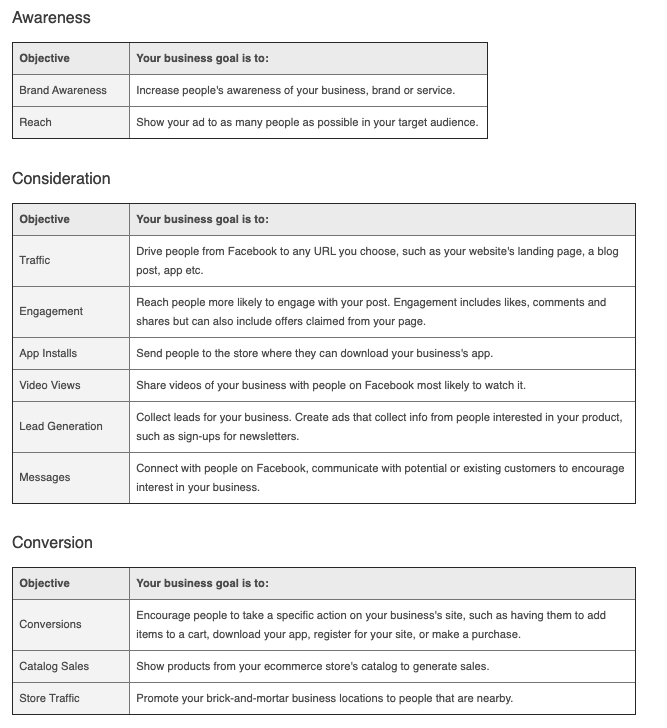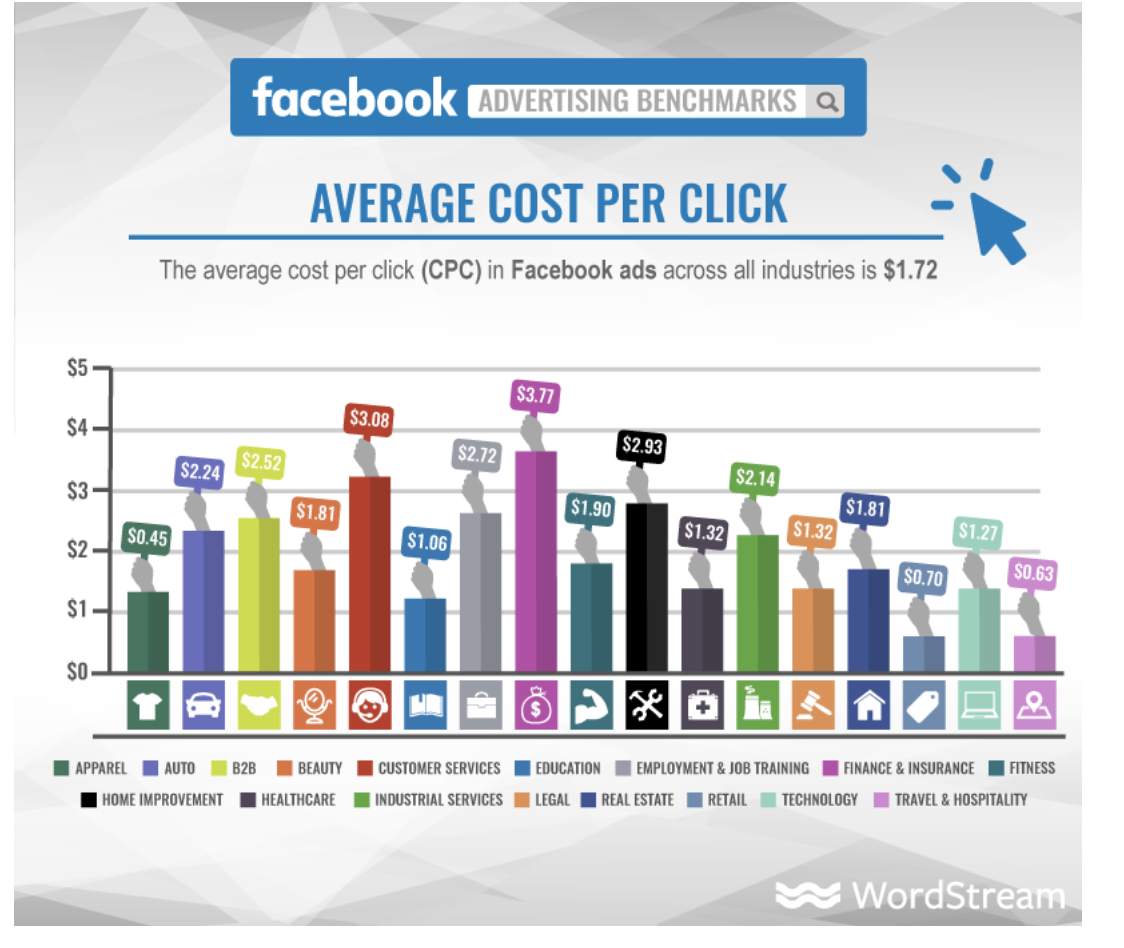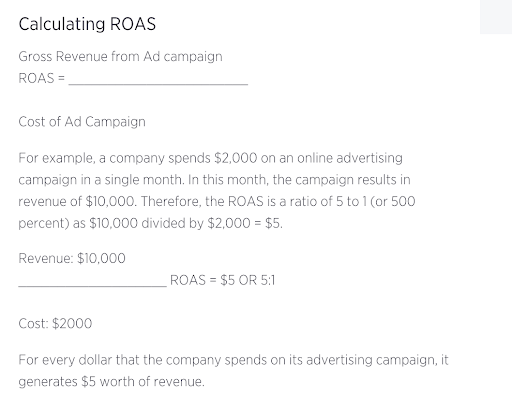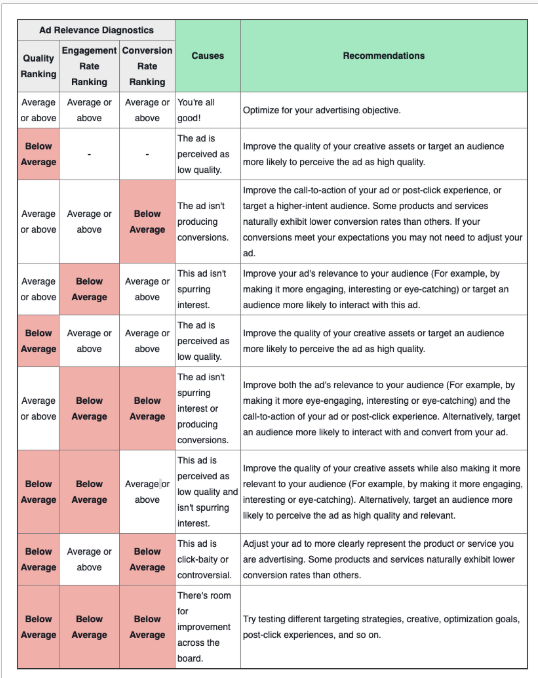Facebook advertising is one of the best ways to gain traction for your business online.
But how much does Facebook advertising really cost?
I’ll break it all down for you in this article.

What We’ll Cover:
- Types of Facebook advertising costs
- Campaign objectives and how they relate to business goals
- Relevance metrics
- Facebook advertising costs by industry
- How competition impacts advertising costs
- Facebook bid strategies
- How to measure the ROAS of your Facebook campaigns
Organic engagement is a lot harder to come by than it used to be on Facebook, thanks to the algorithmic changes the social giant has been introducing throughout the year.
Because of that, paid advertising is your best bet to get ahead.
As social ads become a requirement of the digital landscape rather than just a boost, I’m getting a lot of questions regarding how much of your budget should go toward Facebook Ads.
There’s no hard answer here, as costs vary based on a range of factors from industry and audience to timing and your relevance score. (Yes, Facebook keeps tabs on whether you’re “relevant enough”).
Here, I’ll break down what goes into figuring out your Facebook advertising cost.
Types of Advertising Costs
Facebook ads are charged according to a handful of cost structures, which look similar to what you’ll see on Google—including pay per click, per view, or per thousand impressions.
Advertising costs vary based on the campaign type you choose. And while CPC ads might be the most common ad type, advertisers should carefully weigh their options to ensure that they choose an ad campaign that makes sense for them based on ad type, campaign objectives, and overall advertising goals.
- Cost-per-Click (CPC): Cost-per-click is a pricing model where advertisers are billed based on the number of clicks their ads receive. Because advertisers are charged every time someone clicks on an ad, CPC ads are best suited for campaigns where the intention is to drive traffic to a specific landing page.
- Cost-per-Thousand-Impressions (CPM): CPM campaigns are best suited for increasing awareness.
- Cost-per-View (CPV): CPV measures the number of 3 or 10-second views generated by video ads. While not as “high-intent” as a conversion, Facebook charges advertisers based on users stopping and watching an ad.
- Cost-per-Action (CPA): Cost-per-action allows you to pay only when users take the desired action after viewing your ad. While paying by action is more expensive on average than the other options listed, it can be an effective way to know which ads are driving conversions.
- Cost-per-Like (CPL): Cost per like campaigns are designed to help you grow a following and increase organic reach on Facebook. While it might seem like a vanity metric, getting more likes on your pages functions as a form of social proof and lets users know that your brand is trustworthy. Additionally, likes allow you to collect even more qualitative data about your audience.
Campaign Objectives
Another factor that impacts the cost of your Facebook advertising efforts is the campaign objectives you choose to target.
Generally speaking, campaigns geared toward generating sales or highly-qualified leads will cost more than promoting your brand in front of a new audience.
The reason for this is that something like an app install or a purchase requires more buy-in from the end-user than say an impression, where you’re just paying for someone to (hopefully) notice your ad in their feed. This makes sense; conversions are worth more than clicks or views due to their direct link to profitability.
It’s also worth pointing out that within the impression category, there’s a lot of variation.
According to research from Statista, product catalog sales are the most expensive objective at an average $4.77 CPM, while brand awareness CPMs cost an average of $0.48.
Facebook objectives are broken down into three types, though multiple ad formats fall into each category.
Here’s a breakdown of campaign objectives as they relate to business goals:

Facebook campaign objectives
- Awareness: Awareness and reach campaigns are used to raise your brand’s profile and are paid by impressions. Here, you’ll want to make sure that you target new users by creating entertaining, visually compelling ads that spark users’ curiosity. Brand awareness ads include video, carousel, Instant Experiences, and Instagram awareness ads, and should focus on being attention-grabbing and entertaining. Reach ads are more about showing your ad to the most people possible that fit into your target audience. According to Facebook, reach campaigns aim to “drive audience impact at scale,” a tactic that can help reinforce branding across channels.
- Consideration: Consideration includes a whole range of activities from Traffic and App installs to video views and messages. You’ll pay in CPA. This type of objective is geared towards customers who are already somewhat familiar with your product and would like to know more. You can also set it up for new customers, but keep in mind that you’re asking them to take some sort of action on the ad.
- Conversion: In the Facebook Universe, conversions include Conversions, Catalog Sales and Store Visits. Here, your goal is to get high-intent users to take the next step and make a purchase, book a demo, or visit your physical store.
Align Facebook Ad Campaigns with Overall Business Goals
While it may seem like a no-brainer, your Facebook advertising costs can spiral out of control if you start the process without a plan.
Before you publish your next Facebook ad campaign, you’ll want to make sure you have a clear picture of why you’re doing this.
Is the goal to generate awareness? Get more people to like your page? Drive conversions? Establishing your goal is the first step in figuring out what your Facebook advertising costs will amount to, as again, objectives have varying price points.
Relevance Metrics
Relevance score is a retired Facebook metric that assigned a numeric score to how relevant your ad was to your target audience.
While the single relevance score is no more, Facebook still takes relevance seriously; only now the metric has split into three separate scores.
- Engagement rate ranking: This score is determined by how often users click on your ad or watch a video compared to your competitors. This metric is especially useful for gauging how well your copy and creative work for specific audiences.
- Conversion rate ranking: Conversion rate ranking determines how likely users are to complete the desired action, such as filling out a form or making a purchase.
- Quality ranking: This score is calculated based on feedback received from users compared to the feedback received by your competitors. As more users engage with your ad, you’ll see your relevance score rise. However, if people click the “this ad isn’t relevant to me” or even just ignore it, you’ll see your score drop.
Like Google’s Quality Score, relevance factors into how much the platform charges you, as well as what kind of placements you’ll get.
If you have a high relevance score, Facebook’s algorithm will charge you less for the same placements as competitors with lower scores. That said, Facebook does offer a pretty solid framework for improving low scores:
Facebook Advertising Costs by Industry
Facebook advertising costs, like Google Ads keywords, also vary based on industry.
According to findings from a Wordstream analysis, the average cost per click is $1.72, while the average CPM is $11.20.
Apparel brands pay the least, with a $0.45 CPC, while finance and insurance companies pay $3.77 on average per click. Here’s a breakdown of average costs based on industry:

Average Facebook CPC by industry. Source.
The average cost per action (CPA) across industries is considerably higher at $18.68. If you’re lucky enough to work in the technology sector, that number jumps all the way up to $55.21.

Average Facebook CPA by industry. Source.
Keep in mind that while a $55 CPA seems wild, you must consider the cost in the context of how much B2B SaaS products actually cost–sometimes thousands of dollars a month. Given that, $55 sounds like a pretty good deal.
How Competition Impacts Your Facebook Advertising Costs
Competition, depending on your industry, can be pretty fierce.
Your ad will be competing with thousands of other ads targeting the same audience, even if they have nothing to do with your industry or market share.
To get ahead of the competition, focus on specific audience segments and stick to one segment per campaign to make it easier to track what works for each group.
Similar to how targeting long-tail keywords within a smaller niche helps you reach a narrower market on Google ads, honing in on the exact people you want to reach via Facebook Audiences can net you qualified, high-intent traffic.
Create Multiple Audiences to Gather Intel
The more you can learn about your audience, the easier it’ll be to understand what makes them respond to your ads.
Head over to the Audiences tab in the Ads Manager to create and save audience segments. Here, you’ll find three options:
- Target audience: Use demographic criteria, interests, and behavior to build your audience.
- Custom audience: Upload customer lists or even sources like Google Audiences made up of past customers or website visitors. You’ll need to install the Facebook Pixel to track behavior away from Facebook, which can later be used in retargeting campaigns.
- Lookalike audiences: Facebook finds users similar to the ones you’ve saved in your account, allowing you to find new users likely to be interested in your solutions. Facebook also recently added a new option, Value-based lookalike audiences, which finds new users similar to your customers with the highest lifetime value.
While you may need to run some campaigns based on guesswork to learn more about these groups, keeping your segments small can make it easier to create ads that drive engagement and conversions by connecting ads to landing pages that match your offer.
As you learn more about your audiences, you can reduce costs by targeting “cold” audiences with low-cost, low-commitment content like blog posts and downloads, while using the bulk of your budget to convert hot leads.
Don’t Bid Too High the First Time Around
When you create a campaign for the first time, don’t overbid.
Instead, set a lower budget cap so you can track ad performance. Facebook allows you to choose whether you’d like to set a maximum daily budget or put a lifetime cap on your campaign.
The first option is pretty straightforward, whereas the lifetime cap allows Facebook to maximize bids as the algorithm sees fit.
As I’ve mentioned when discussing Google’s smart bidding options, letting the algorithm take over tends to work best on accounts with a lot of historical performance data to draw upon. While both options can be adjusted as needed, you may want to set a daily budget if you prefer to have more control over the campaign.
Bid Strategies
Facebook only offers one manual bidding strategy, Bid Cap, noting that the more control you maintain over bids, the more constraints you place on the platform when it comes to identifying low-cost opportunities.
Essentially, they’re saying the algorithm can prevent you from bidding more than an action is worth–though that also means giving up control.
- Bid Cap: Using bid caps allows you to maximize conversions while staying within your budget. Objectives include awareness, reach, traffic, engagement, views, conversions, catalog sales, messages, likes, and lead gen. Bid cap is the lone manual strategy on this list, offering control over costs and an opportunity to edge out competitors bidding on similar audiences. Keep in mind, the bid is different than the cost per result, so reports may look different than what you were expecting.
- Cost Cap: Best for getting the most volume while maximizing cost efficiency, cost cap spans a wide range of objectives and allows advertisers to minimize costs when possible without manually taking action.
- Lowest Cost: Lowest cost is an auto-bidding strategy where Facebook aims to capitalize on all available low-cost opportunities while spending your budget. This approach is best used when you want to spend your entire budget and pick up low-hanging fruit. Still, costs can get out of hand if you’re not careful, as Facebook is in full control.
- Target Costs: Bidding on target costs means you’ll set a target amount and Facebook will aim to get the most conversions at that target cost. This strategy can be used on traffic, lead generation, app installs, conversions or catalog sales and is designed to give advertisers predictable Facebook advertising costs.
- Value optimization with min ROAS: This bidding strategy applies only to conversions, installs, and catalog sales. You’ll give Facebook your minimum ROAS and the algorithm will get the most opportunities while sticking to that minimum target.
- Highest Value: Another auto-bid strategy Facebook recommends using this strategy to get the highest ROAS while spending your full budget, particularly if you don’t know your minimum ROAS. It is also used for app installs, conversions, and catalog sales.
How to Measure the ROAS of Your Facebook Campaigns
Return on ad spend (ROAS) is a metric that lets you know whether your marketing efforts were effective from a financial standpoint.
The formula is relatively easy. Simply divide the total revenue generated from your ad campaign by the total cost of running the campaign.
Keep in mind, this goes beyond your Facebook advertising costs and includes money spent on labor, materials, commissions, anything associated with selling the products advertised.
Here’s how the calculation breaks down, according to BigCommerce:

How to calculate ROAS. Source
To learn more about ROAS and how it’s calculated, check out my full guide here.
Wrapping Up
Admittedly, there’s a lot to consider when it comes to assessing Facebook costs.
While it may be a bit overwhelming at first, Facebook Ads allow you to gather a lot of intel about your audiences, along with the reporting tools to help you learn what’s working and what’s not.
There’s no way to know for sure what Facebook will cost you, but having a well-informed and calculated budget will help guide you and ensure you aren’t spending money needlessly.
Look at the averages in your industry and determine how much you plan to spend in the ad creation process. From there, you can begin to discern what a proper budget might look like
In the end, you’ll want to make sure you’re either in control of your bidding activity or that you keep a close eye on the algorithm and that you start this strategy knowing how much an action, a click, or an impression is worth to you.

